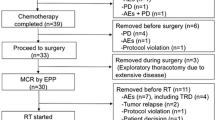Abstract
From 1984 to 1989, 63 patients with diffuse, malignant mesothelioma of the pleura were treated with 4-8 courses of high-dose methotrexate (HDMTX, 3 g total dose) and citrovorum factor rescue. There were 61 male and two female patients of median age 60 years. CT scan was performed before and after treatment and used for response evaluation. Of 60 patients evaluable for response, 37% showed partial or complete remission, 32% showed no change and 32% showed progressive disease. Median survival from start of treatment for all patients was 11 months, for 42 patients with the epithelial type 12 months, and for 20 patients with sarcomatous or mixed types only 5 months. Toxicity was acceptable, with only five patients (8%) terminating therapy due to toxicity. One toxic death occurred. We conclude that HDMTX is an active regimen in malignant pleural mesothelioma. The significantly shorter survival for patients with the sarcomatous or mixed subtypes indicates that further investigations on the activity of HDMTX in mesothelioma should be limited to patients with the epithelial subtype.
Similar content being viewed by others
Author information
Authors and Affiliations
Rights and permissions
About this article
Cite this article
Solheim, Ø., Sæter, G., Finnanger, A. et al. High-dose methotrexate in the treatment of malignant mesothelioma of the pleura. A phase II study. Br J Cancer 65, 956–960 (1992). https://doi.org/10.1038/bjc.1992.200
Issue Date:
DOI: https://doi.org/10.1038/bjc.1992.200
- Springer Nature Limited
This article is cited by
-
Systemic Treatments for Mesothelioma: Standard and Novel
Current Treatment Options in Oncology (2008)
-
Advances in diagnosis and treatment of malignant pleural mesothelioma
Oncology Reviews (2007)




